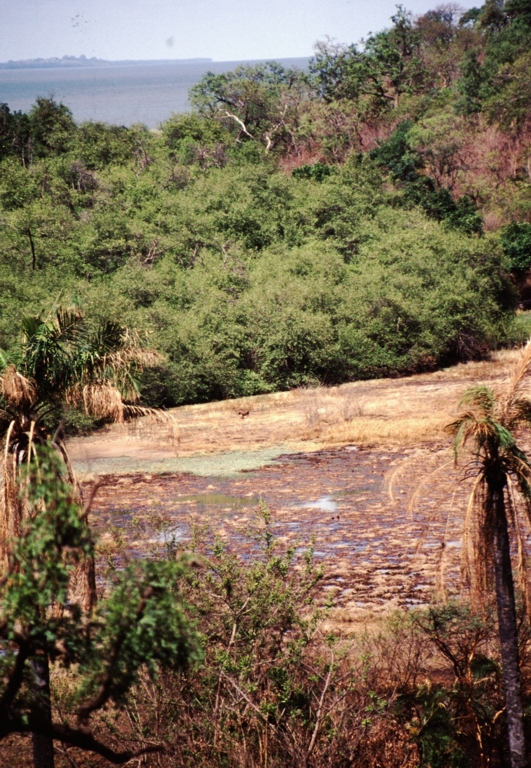- Kiang West National Park
Infobox_protected_area | name = Kiang West National Park
iucn_category = II

base_width = 250
caption =
locator_x =
locator_y =
location = flag|Gambia
nearest_city =
long_degrees =15
long_minutes =55
long_seconds =
long_direction =W
lat_degrees =13
lat_minutes =23
lat_seconds =
lat_direction =N
area = 115 square kilometres (28,417 acres)
established =1987
visitation_num =
visitation_year =
governing_body =The Gambia Department of Parks and Wildlife ManagementKiang West National Park is one of the largest and most important wildlife reserves in
The Gambia .cite book |title=The Gambia & Senegal |last=Burke |first=Andrew |year=2002 |publisher=Lonely Planet |isbn=1740591372 |pages=176 |url=http://books.google.ie/books?id=wzSeSABeZV0C ] It was gazetted as anational park in 1987 and is managed by The Gambia Department of Parks and Wildlife Management.Geography
The park covers an area of 115 square kilometres (28,417 acres), and is located on the south bank of the
Gambia River , in theLower River Division in theKiang West District. The park is located about 5 kilometres (3 miles) away fromTendaba village, 145 kilometres (90 miles) from The Gambia's capital cityBanjul , and 100 kilometres (62 miles) from The Gambia's coastline. The Gambia River marks the park's northern boundary. Three "bolons" (creeks)—the Jarin, Jali, and Nganingkoi—divide the park's interior into three sections. The park is unpopulated, with villages located close outside its borders.cite web |url=http://www.birdlife.org/datazone/sites/index.html?action=SitHTMDetails.asp&sid=6353&m=0 |title=Kiang West National Park |accessdate=2008-08-07 |work=BirdLife's online World Bird Database: the site for bird conservation |publisher=BirdLife International |date=2008 ]Most of the park is located on a plateau of low altitude, and is mostly Guinea savanna and dry
deciduous woodland, and it also has tidal flats and mangrove creeks.cite book |title=The Rough Guide to West Africa |last=Hudgens |first=Jim |coauthors=Richard Trillo, Nathalie Calonnec |year=2003 |publisher=Rough Guides |isbn=1843531186 |pages=300 |url=http://books.google.ie/books?id=2icviOKxDNIC ]Flora
Vegetation types in the park include Guinean savanna and dry deciduous woodland. The park's tree species include the baobab ("Adansonia digitata"), red acacia ("Acacia seyal"), "
Pterocarpus erinaceus ", "Ceiba pentandra ", "Terminalia macroptera", "Prosopis africana", andFicus species. Grasses in the park include "Andropogon ".cite web |url=http://sea.unep-wcmc.org/sites/pa/0438p.htm |title=Kiang West National Park |accessdate=2008-08-07 |work= |publisher=United Nations Environment Programme |date=May 1985 ]Fauna
The park is an important area for The Gambia's wildlife, as individuals of most of its remaining mammal species are found within it. These mammals include the
African clawless otter ("Aonyx capensis"),Bushbuck ("Tragelaphus s. scriptus"),Caracal ("Caracal caracal"),Common duiker ("Sylvicapra grimmia"),Leopard ("Panthera pardus pardus"),Marsh Mongoose ("Atilax paludinosus"),Serval ("Leptailurus serval"),Sitatunga ("Tragelaphus spekii"),Spotted hyena ("Crocuta crocuta"),Warthog s ("Phacochoerus africanus"), andWest African manatee ("Trichechus sengalensis").West African manatee s andHumpback Dolphin s are sometimes observed in the Jarin "bolon".The park's reptile species include the
African python ("Python sebae"),Bell’s Hinged Tortoise ("Kinixys belliana nogueyi"),Nile crocodile ("Crocodylus niloticus"),Nile monitor ("Varanus niloticus"),Puff adder ("Bitis arietans"),Royal python ("Python regius"), andSpitting cobra ("Naja nigricollis").cite web |url=http://gambiaparkswildlife.net/?q=node/70 |title=Kiang West National Park |accessdate=2008-08-07 |work= |publisher=The Gambia Department of Parks and Wildlife Management |date= ]The park has more than 300 bird species, over half of all the bird species that have been recorded in The Gambia. Some of the park's bird species have a very local distribution and are rarely observed in other locations in The Gambia. There are 21
birds of prey , includingeagle ,falcon ,harrier ,hawk , andvulture species. There are quite a large number of birds of prey in the park during the dry season. Other bird species in the park include tenKingfisher species, theGround-hornbill , and the threatenedBrown-necked Parrot ("Poicephalus robustus fuscicollis"), which breeds in the park's mangroves. Other bird species include White-fronted Black-chat ("Myrmecocichla albifrons"), Dorst's Cisticola ("Cisticola dorsti"), Burchell's Courser ("Cursorius rufus"), Brown-rumped Bunting ("Emberiza affinis") and Chestnut-crowned Sparrow-weaver ("Plocepasser superciliosus"), which have restricted distributions in The Gambia. TheBateleur ("Terathopius ecaudatus"), a short tailed eagle species, is the park's official symbol. The Bateleur hunts forsandgrouse andpigeon s in the park, and is most often seen there from July to September.cite book |title=The Gambia |last=Gregg |first=Emma |coauthors=Richard Trillo |year=2003 |publisher=Rough Guides |isbn=184353083X |pages=193-194 |url=http://books.google.ie/books?id=FjteEhM_MFAC&pg=PA194&vq=kiang+west&source=gbs_search_r&cad=1_1&sig=ACfU3U0ELGIG_S3FdKNJCEEjYrO-T-2zkw#PPA194,M1 ]Conservation and tourism
Local people are permitted gather a small amount of firewood and forest products, and to cultivate some rice within the park's boundaries. Annual forest fires badly affect the park. In 2001, a large fire burned through the length of the park for two days.cite book |title=Why don’t they come and discuss together? Community-initiated stakeholder co-ordination on forest fire management in rural Gambia |last=Sonko |first=Kebba |coauthors=Saikou Samateh, Kanimang Camara, Clemens Beck |year= |publisher= |location= |isbn= |pages= |url=http://www.asiaforests.org/doc/resources/fire/CBFiM/Chapter%2012.pdf ]
The park receives few tourists. November to January are the best months to visit the park. The park's headquarters and tourist bungalows are located at
Dumboto . Tendaba Camp inTendaba village has been open since the 1970s and is the most established base for trips to the national park. Chalets in this camp provide accommodation for tourists. The park's road system is underdeveloped.Tubabkollon Point , located near a sandy beach beside the Gambia River in the northeast of the park, is a good place for visitors to watch wildlife. The park is becoming well known as a good place for birdwatching.References
Wikimedia Foundation. 2010.
